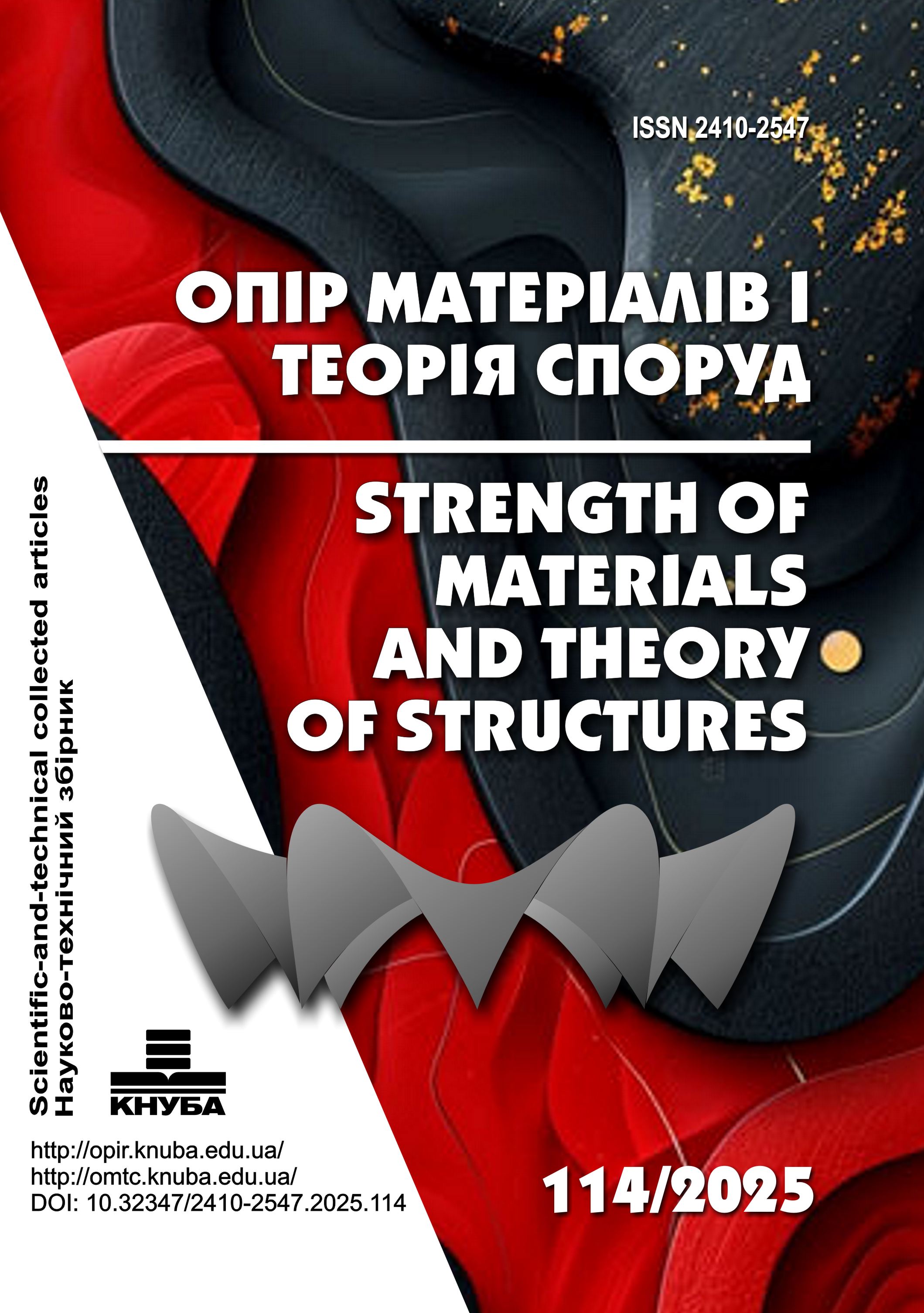Method for determining the foundation stiffness coefficient based on its physical and mechanical characteristics and the theory of a linear-elastic half-space
DOI:
https://doi.org/10.32347/2410-2547.2025.114.202-210Keywords:
stiffness coefficient, modulus of subgrade reaction, finite element method, depth of the compressed zone, soil foundation, settlementAbstract
The reliability and durability of building structures largely depend on the proper consideration of their interaction with the soil foundation. Determining foundation deformations is a key stage in design, as it defines the structural behavior under load. Both analytical methods and numerical approaches are used for calculations, among which the finite element method (FEM) is the most widely applied.
Numerical modeling based on FEM allows for the simulation of the soil foundation as a finite bounded domain, using various mathematical soil models and appropriate boundary conditions. An alternative approach is to model a flexible foundation as a slab on an elastic Winkler foundation, where a critical step is determining the stiffness coefficients (coefficient of foundation subgrade reaction): C1 (subgrade reaction coefficient) and C2 (shear coefficient). However, regulatory documents do not provide clear recommendations for their determination.
The authors propose a method for calculating the bed coefficient C1, which eliminates the need for settlement calculations and relies solely on the average soil deformation modulus, the compressed layer depth parameter, and special coefficients that account for the decrease in stress intensity with depth according to the theory of a linear-elastic half-space. These coefficients are provided in an easy-to-use tabular format and can also be applied for analytical assessment of settlement magnitudes using the derived formulas.
References
Solodei, I., Petrenko, E., & Zatyliuk, Gh. (2020). Nonlinear problem of structural deformation in interaction with elastoplastic medium. Strength of Materials and Theory of Structures, 105, 48–63. https://doi.org/10.32347/2410-2547.2020.105.48-63
Zhupanenko, I. (2020). Chyselnyi analiz metodiv rozrakhunku gruntovoi osnovy ta metodiv vyznachennia koefitsiientiv posteli (Numerical analysis of methods for calculating the soil base and methods for determining bed coefficients). Bases and Foundations, (41), 64-71. https://doi.org/10.32347/0475-1132.41.2020.64-71
Strelets–Streletsky, E., Zhuravlev, A., & Vodopyanov, R. (2019). LIRA-SAPR. Knyha I. Osnovy (LIRA-SAPR. Book I. Basics. (A. Gorodetsky, Ed.). LIRALAND.
Solodei, I.I., & Zatyliuk, Gh.A.. (2022). Doslidzhennia dostovirnosti ta efektyvnosti vykorystannia modelei zmitsniuvanoho gruntu v ramkakh metoda skinchennykh elementiv. Opir materialiv ta teoriia sporud (Study of the reliability and efficiency of using reinforced soil models within the framework of the finite element method). Strength of Materials and Theory of Structures, (109), 30-37. https://doi.org/10.32347/2410-2547.2022.109.30-37
Lytvyn, O. (2024). Metodyka vrakhuvannia protsesu ushchilnennia gruntiv pry otsintsi vzaiemodii konstruktsii z gruntovoiu osnovoiu metodom skinchennykh elementiv (Methodology for taking into account the process of soil compaction when assessing the interaction of structures with the soil base using the finite element method). Strength of Materials and Theory of Structures, (113), 352-359. https://doi.org/10.32347/2410-2547.2024.113.352-359
Duncan, J. M., & Chang, C. Y. (1970, September). Nonlinear Analysis of Stress and Strain in Soils. Journal of the Soil Mechanics and Foundations Division, 96(5), 1629–1653. https://doi.org/10.1061/jsfeaq.0001458
Schanz, T., Vermeer, P., & Bonnier, P. (2019, January 22). The hardening soil model: Formulation and verification. Beyond 2000 in Computational Geotechnics, 281–296. https://doi.org/10.1201/9781315138206-27
Janbu, N. (1963). Soil compressibility as determined by oedometer and triaxialtests. Proc. ECSMFE Wiesbaden. 1, 19–25.
Downloads
Published
Issue
Section
License

This work is licensed under a Creative Commons Attribution 4.0 International License.
Authors retain copyright and grant the journal right of first publication with the work simultaneously licensed under a Creative Commons Attribution License that allows others to share the work with an acknowledgement of the work's authorship and initial publication in this journal.

